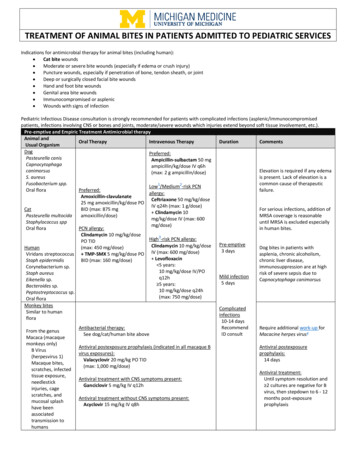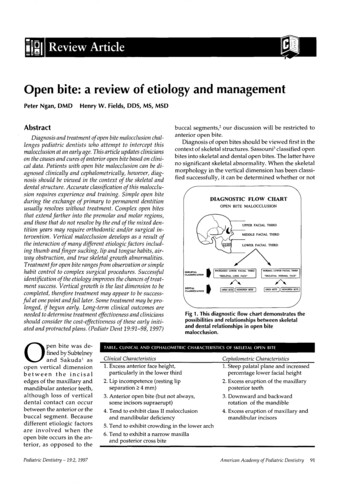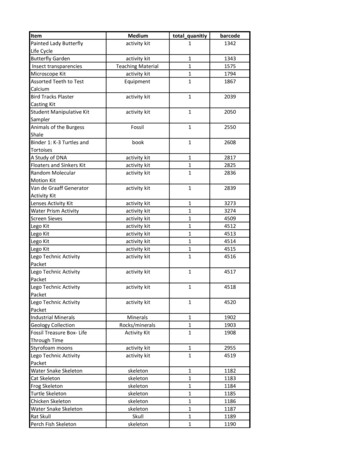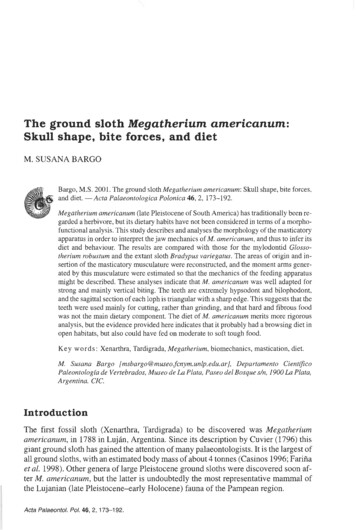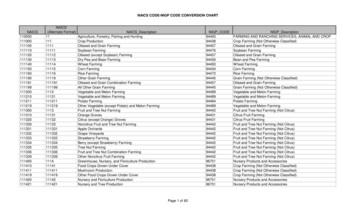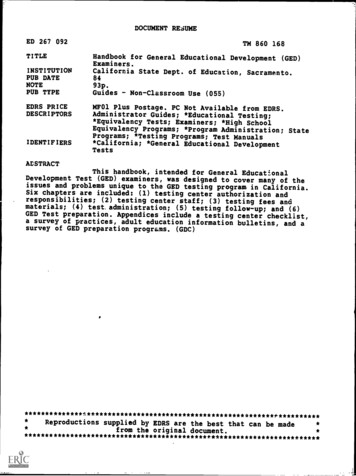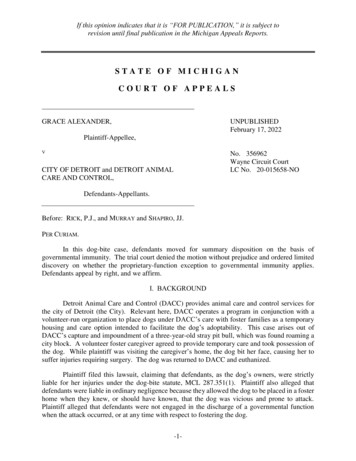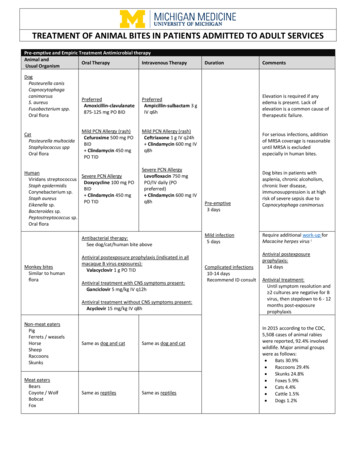
Transcription
TREATMENT OF ANIMAL BITES IN PATIENTS ADMITTED TO ADULT SERVICESPre-emptive and Empiric Treatment Antimicrobial therapyAnimal andOral TherapyIntravenous TherapyUsual OrganismDogPasteurella canisCapnocytophagacanimorsusS. aureusFusobacterium spp.Oral floraCatPasteurella multocidaStaphylococcus sppOral floraPreferredAmoxicillin-clavulanate875-125 mg PO BIDPreferredAmpicillin-sulbactam 3 gIV q6hMild PCN Allergy (rash)Cefuroxime 500 mg POBID Clindamycin 450 mgPO TIDMild PCN Allergy (rash)Ceftriaxone 1 g IV q24h Clindamycin 600 mg IVq8hHumanSevere PCN AllergyViridans streptococcusDoxycycline 100 mg POStaph epidermidisBIDCorynebacterium sp. Clindamycin 450 mgStaph aureusPO TIDEikenella sp.Bacteroides sp.Peptostreptococcus sp.Oral floraSevere PCN AllergyLevofloxacin 750 mgPO/IV daily (POpreferred) Clindamycin 600 mg IVq8hAntibacterial therapy:See dog/cat/human bite aboveMonkey bitesSimilar to humanfloraAntiviral postexposure prophylaxis (indicated in allmacaque B virus exposures):Valacyclovir 1 g PO TIDAntiviral treatment with CNS symptoms present:Ganciclovir 5 mg/kg IV q12hAntiviral treatment without CNS symptoms present:Acyclovir 15 mg/kg IV q8hNon-meat eatersPigFerrets / weaselsHorseSheepRaccoonsSkunksSame as dog and catSame as dog and catMeat eatersBearsCoyote / WolfBobcatFoxSame as reptilesSame as reptilesDurationCommentsElevation is required if anyedema is present. Lack ofelevation is a common cause oftherapeutic failure.For serious infections, additionof MRSA coverage is reasonableuntil MRSA is excludedespecially in human bites.Pre-emptive3 daysMild infection5 daysComplicated infections10-14 daysRecommend ID consultDog bites in patients withasplenia, chronic alcoholism,chronic liver disease,immunosuppression is at highrisk of severe sepsis due toCapnocytophaga canimorsusRequire additional work-up forMacacine herpes virus iAntiviral postexposureprophylaxis:14 daysAntiviral treatment:Until symptom resolution and 2 cultures are negative for Bvirus, then stepdown to 6 - 12months post-exposureprophylaxisIn 2015 according to the CDC,5,508 cases of animal rabieswere reported, 92.4% involvedwildlife. Major animal groupswere as follows: Bats 30.9% Raccoons 29.4% Skunks 24.8% Foxes 5.9% Cats 4.4% Cattle 1.5% Dogs 1.2%
Animal andUsual OrganismReptiles(Iguana, turtle, lizard)Oral floraSalmonella sppYersinia sppS. marcescensAeromonas sppOral TherapyIntravenous TherapyPreferredAmoxicillin-clavulanate875-125 mg PO BIDPreferredPiperacillin-tazobactam4.5 g IV q6hMild PCN Allergy (rash)Cefpodoxime 400 mgPO BID Metronidazole 500mg PO TIDMild PCN Allergy (rash)Ceftriaxone 1 g IV q24h Metronidazole 500 mgIV q8hSevere PCN AllergyLevofloxacin 500 mg POdaily Metronidazole 500mg PO TIDSnake bites iiOral floraFecal flora ofingested preyStaphylococcus spp.StreptococciEscherichia coliMorganella morganiiEnterococcus faecalisPseudomonasaeruginosaED Snake BiteEnvenomation ProtocolRatStreptobacillusmoniliformis (USA)Spirillium minus (Asia)Recommend ID consultfor follow up purposesPreferredAmoxicillin-clavulanate875-125 mg PO BID Ciprofloxacin 750 mgPO BIDPCN AllergyLinezolid 600 mg POBID Ciprofloxacin 750 mgPO BID Metronidazole 500mg PO TIDSevere PCN AllergyLevofloxacin 750 mgPO/IV daily (POpreferred) Metronidazole 500 mgIV q8hPreferredPiperacillin-tazobactam4.5 g IV q6hDurationPre-emptive3 daysIf clinical evidence of infectionPenicillin 2 million units IV q4horCeftriaxone 1 g IV q24horDoxycycline 100 mg PO q12hComplicated infections10-14 daysRecommend IDconsultOnly a minority of snake bitesbecome infected and needantibiotics.Most infection of snakebites areassociated with the introductionof pathogenic bacteria duringattempts at management in thefieldFor serious infections, additionof MRSA coverage is reasonableuntil MRSA is excluded.Duration3 daysDuration10-14 days foruncomplicatedinfectionsPage 2 of 5For serious infections, additionof MRSA coverage is reasonableuntil MRSA is excluded.Mild infection5 daysPCN AllergyVancomycin 15 mg/kg IVq12h Aztreonam 2 g IV q8h Metronidazole 500 mgIV q8hIf no evidence of infection prophylactic antibiotics canbe consideredPenicillin VK 500 mg PO QIDorDoxycycline 100 mg PO BIDCommentsUp to 10% of rat bites can leadto infection.S. moniliformis can also becarried by hamsters and otherlaboratory rodentsHandling of a dead rat has beenreported to cause rat bite feverCan observe if decide not to useantibiotics as most patients willpresent within 7 days
ses,Woodchucks,Dogs,Cats,Ferrets,Most othercarnivores ivOrganismClostridium tetani(tetanus)Empiric Vaccination RecommendationsVaccination indicationsThose vaccinated 5 yearsago with DTaP, Tdap, or Tdrevaccination is not indicatedThose vaccinated 5 years agoor never vaccinated,vaccination is indicatedContact health departmentfor further direction onanimal containment andtesting (see below text forinstructions)Lyssavirus spp.(rabies)If the animal tests positive forrabies or the status is unknownand the animal has a highlikelihood of being a carrier,rabies immune globulin andvaccine can be considered (seeMichigan Rabies Assessmentfor guidance)Vaccination RecommendationsNever received Tdap:Tdap (ADACEL ) IM x1 doseIf previously vaccinated with Tdap:Td (TENIVAC ) IM x1 doseIf severe or uncleaned wound and 2 previous vaccines (orunknown vaccination history):Tetanus Immune Globulin (HYPERTET ) iii 250 units IM x1 doseIf immunocompetent and previously unvaccinated with rabiesvaccine:Rabies Immune Globulin 20 units/kg infiltrated to the wounds(with remaining administered IM into the deltoid) x1 dose Human Diploid Rabies Vaccine v IM x4 doses (dosed on days0, 3, 7, and 14)If immunocompromised and previously unvaccinated with rabiesvaccine:Rabies Immune Globulin 20 units/kg infiltrated to the wounds(with remaining administered IM into the deltoid) x1 dose Human Diploid Rabies Vaccine 7 IM x5 doses (dosed on days0, 3, 7, 14, and 28)If previously vaccinated with rabies vaccine vi:Human Diploid Rabies Vaccine 7 IM x2 doses (dosed on days 0and 3)Further questions can be directed to Infectious Diseases.Page 3 of 5
ACTIONS1. Inform the patient that the animal bite will be reported to the Public Health Department and to Law Enforcement (for purposes of reporting tothe appropriate Animal Control Authorities).2. All animal bites and exposures to bats should be reported to the Washtenaw County Public Health Department (WCPHD) by staff. Completethe attached Animal Bite Report form and fax to WCPHD at (734) 544-6706. Go to WCPHD website for more info:https://www.washtenaw.org/1795/Rabies3. Contact WCPHD at (734)544-6700 for advice regarding sending bats or other animals for rabies testing.4. Hospital Security, Law Enforcement & Animal Control Notification:a. Healthcare provider must report the bite to UMHS Hospital Security by providing Security with the following information: animalbite victim’s name; hospital registration number; date of birth; hospital location/room number.b. Upon notice from health care provider, Hospital Security will dispatch a security officer to obtain the details about the animal biteincident from the animal bite victim. The type of information obtained includes:i. Full Name and address of the victim;ii. Information about the animal (e.g., type of animal, whether wild or domestic pet, etc., as applicable);iii. If known and applicable, name and address of the animal’s owner;iv. Location where the incident occurred;v. Cause, character and extent of the injury;vi. How the incident occurred; andvii. Other related and/or aggravating circumstances regarding the incident (e.g., was animal provoked)c. In cases where a patient or his/her personal representative is not able to provide the information directly to the Hospital SecurityOfficer (e.g., unconscious patient, no personal representative available) the Hospital Security Officer may obtain information aboutthe animal bite (e.g., location, severity, etc.) verbally from the treating health care providers.d. UMHS Hospital Security reports only the animal bite information set forth in Section 4B above to the University of MichiganDepartment of Public Safety (DPS) via phone and security dispatch report (DPS thereafter notifies the appropriate law enforcementagency/animal control officer for the jurisdiction in which the bite occurred).5.Wound management:a. Stabilization/Evaluation – Animal bites should be treated as contusions though they may also have significant lacerations or deeppunctures. Initial treatment with ice and elevation will help reduce swelling. Direct pressure will control actively bleeding wounds.Consideration should be given to potential injury to deep or surrounding structures. A careful neurovascular examination of theinjured area should be performed prior to the instillation of local anesthetics. A musculoskeletal exam should be performed withattention to integrity of deep and adjacent structures. Consider imaging if concern for boney injury or foreign body exists (e.g., plainradiograph or ultrasound). Lacerations over the metacarpophalangeal joints should raise suspicion for possible human bite (i.e., fightbite) injuries.b. Clean wound – Appropriate local anesthesia facilitates adequate wound cleaning. Wounds should be washed with soap and water assoon as possible thorough wound cleaning may help reduce likelihood of rabies transmission.c. Lacerations – To reduce the counts of bacteria present in the wound, the surface should be cleaned with povidone iodine and thedepths irrigated with copious amounts of saline using pressure irrigation from a syringe. Wounds should be explored for foreignbody, or deep structure injury, devitalized tissue should be debrided. Wounds over or near joints should be explored carefullythrough a range of motion to assess for damage to the underlying tendon sheath, fascia, joint capsule, etc.d. Puncture wounds – Inspect wound for evidence of deep puncture, especially if the wound is located in the scalp or near a joint.Remove any foreign bodies or gross wound contaminants. Superficially irrigate the wound, avoiding high pressure irrigation into thewound. Avoid removal of deep tissue (e.g., "coring").e. Wound closure – Closure of a bite wound may increase the risk of infection depending on species inflicting the bite, location, typeand age of wound and host factors. In general, wound closure is discouraged except in locations where cosmetic or functionalimpairment may result. (e.g., facial bite wounds, etc.)Page 4 of 5
References1. John E. Bennett, Raphael Dolin, Martin J. Blaser. Mandell, Douglas, And Bennett's Principles and Practice of Infectious Diseases 8thedition. Philadelphia, PA : Elsevier/Saunders, 2015.2. Cohen JI, Davenport DS, Stewart JA, et al. Recommendations for prevention of and therapy for exposure to B virus (CercopithecineHerpesvirus 1). Clin Infect Dis. (2002) 35 (10): 1191-1203.3. Chamber, HF, Eliopoulos GM, Gilbert DN, Saag MS. The Sanford Guide to Antimicrobial Therapy 48th edition. Sperryville, VA, USA :Antimicrobial Therapy, Inc, 20184. Johns Hopkins ABX Guide, Johns Hopkins Guide. Retrieved ohns Hopkins ABX Guide/540602/all/ About5. Abrahamian FM, Goldstein EJC. Microbiology of Animal Bite Wound Infections. Clinical Microbiology Reviews. 2011;24(2):231-246.6. Geisler WM, Malhotra U, Stamm WE. Bone Marrow Transplant. 2001 Dec;28(12):1171-3.7. Miami-Dade Fire Rescue Venom Response Program. Special venom considerations. asp8. Michigan Department of Health and Human Services. Emerging and Zoonotic Infectious Diseases Section. Rabies assessment flowchart.9. Stevens DL, Bisno AL, Chambers HF, et al. Practice guidelines for the management of skin and soft tissue infections: 2014 update by theInfectious Diseases Society of America. Clin Infect Dis. (2014) 59 (2): e10-e52.10. University of Michigan Health System Emergency Department Guideline 02-10-131 (UMHS ED Snake Bite Envenomation Protocol)11. University of Michigan Health System Emergency Department Policy 02-16.3-014 (Animal Bites, excluding monkeys)12. University of Michigan Health System Emergency Department Guideline 02-16-087 (Monkey Bite/Scratch/Exposure Protocol)13. Washtenaw County Public Health. Animal bites & bats & rabies. https://www.washtenaw.org/1795/RabiesiMacaque monkey bites require additional workup for Macacine herpesvirus 1 (Herpes Simiae or Herpes B), please see the ED MonkeyBite/Scratch/Exposure Protocol (Macacine herpesvirus 1)iiSnake bites require contact with Michigan Poison Control (1-800-222-1222, ask specifically to speak with the toxicologist). Poison Control tracksavailable anti-venom supply and can assist in rapidly obtaining appropriate anti-venom. Please see the ED Snake Bite Envenomation ProtocoliiiIVIG can be used in place of Tetanus Immune Globulin if Tetanus Immune Globulin is unavailable.ivBites of squirrels, hamsters, guinea pigs, gerbils, chipmunks, rats, mice and other rodents, rabbits, hares, and pikas almost never require rabiespost-exposure prophylaxisvRabies vaccinations should not be administered at or near the same site as the Rabies Immune Globulin. Rabies vaccinations should not beadministered to the gluteal region; may decrease efficacyviPatients who received post exposure prophylaxis for a previous exposure, people who received a 3-dose, IM pre-exposure regimen, or those whohave a documented adequate rabies virus antibody titer after previous immunization with any vaccine.Author: Ji Baang, MDLast edited: 3/20/2020Antimicrobial Subcommittee Approval: 11/2018, 03/2020P&T Approval: 12/2018, 05/2020Revision History:03/2020: Added B virus treatment, adjusted reptile bite recommendationsOriginated:Last Revised:Unknown03/2020The recommendations in this guide are meant to serve as treatment guidelines for use at Michigan Medicine facilities. If you are an individual experiencing a medicalemergency, call 911 immediately. These guidelines should not replace a provider’s professional medical advice based on clinical judgment, or be used in lieu of anInfectious Diseases consultation when necessary. As a result of ongoing research, practice guidelines may from time to time change. The authors of these guidelineshave made all attempts to ensure the accuracy based on current information, however, due to ongoing research, users of these guidelines are strongly encouraged toconfirm the information contained within them through an independent source.If obtained from a source other than med.umich.edu/asp, please visit the webpage for the most up-to-date document.Page 5 of 5
d. UMHS Hospital Security reports only the animal bite information set forth in Section 4B above to the University of Michigan Department of Public Safety (DPS) via phone and security dispatch report (DPS thereafter notifies the appropriate law enforcement agency/animal control officer for the jurisdiction in which the bite occurred). 5.
